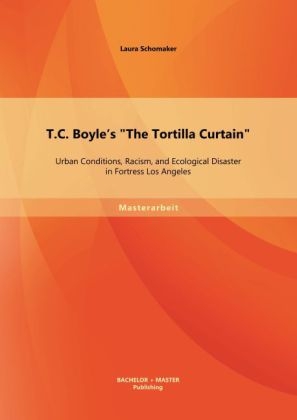
T.C. Boyle's "The Tortilla Curtain": Urban Conditions, Racism, and Ecological Disaster in Fortress Los Angeles
Bachelor + Master Publishing (Verlag)
978-3-95684-108-8 (ISBN)
Laura Schomaker wurde 1987 in Ratingen geboren. Ihr Studium der Medien- und Kulturwissenschaft an der Heinrich-Heine-Universität Düsseldorf schloss die Autorin im Jahre 2010 mit dem akademischen Grad Bachelor of Arts erfolgreich ab. Ihr weiterführendes Studium der Literatur und Medienpraxis sowie American Studies an der Universität Duisburg-Essen beendete sie 2013 erfolgreich mit dem akademischen Grad Master of Arts.
Textprobe:
Kapitel 4, T.C. Boyle s The Tortilla Curtain:
4.1,Arroyo Blanco: The Fortress Community:
T.C. Boyle s novel The Tortilla Curtain seizes the urban reality of white flight, of segregationist settlement patterns and suburbanization penetrating deeper and deeper into the mountains within the Los Angeles region. In this respect, the novel s white protagonists, the Mossbachers, live in the private community Arroyo Blanco Estates (Boyle 30) in Topanga Canyon (ibid. 32), which extends northwards from the Pacific coast into [ ] the Santa Monica Mountains [ ] between Santa Monica and Malibu (Freese 222 f.). The houses within the community are all built in the Spanish Mission style (Boyle 30), the orange roof optional with a Navajo trim (ibid.). However, not only the built environment, but moreover nature is here marked by Spanish designations, such as arroyo , canyon , or chaparral (cf. Schäfer-Wünsche 406). And also some Native American place-names survive in Spanish spellings of the original sounds: Topanga, [ ] Malibu (Cruz 74), and so on. The predominance and mixing of Spanish and Native American words thus reflects L.A. s complex history of migrations and conquests. So because the name of the community already betrays that it is erected on land that was once Spanish and then Mexican (Freese 223), the use of the Spanish language is highly ironic in this context. After all,
Arroyo Blanco is indeed blanco, that is, all-white. No Spanish is spoken here, except by maids and construction workers, and the latter get to build the gate and the wall that are supposed to keep them out (Schäfer-Wünsche 407).
That the fictional homogeneous, suburban community seeks to construct also additional, namely material, barriers in the form of a gate and wall as a response to the emerging postsuburbia and the re-Latinization of Los Angeles, again perfectly mirrors urban reality. And, as in real life, the wealthy homeowners nevertheless rely on their immigrant servants. Thus, also the Mossbachers have a housemaid, Orbalina, whose English [is] limited to a response to the six or seven most common scullery commands (Boyle 271). Of course, a certain irony lies furthermore in the fact that the wall and gate are built by illegal Mexicans - exactly those people the Arroyo Blanco residents want to exclude by enclosing their community. However, these are not the only measures by which the community exercises control. In this sense, the powerful homeowner association lays down specific rules and restrictions, for example concerning the design of the houses:
If you wanted to paint your house sky-blue or Provençal-pink with lime-green shutters, you were perfectly welcome to move into the San Fernando Valley or to Santa Monica or anywhere else you chose, but if you bought into Arroyo Blanco Estates, your house would be white and your roof orange (ibid. 30).
Thus, the principal of democratic freedom is here significantly constrained by the community s private government . Accordingly, the latter is also very anti-communal and does not feel any responsibility for others. This is especially expressed by Jack Jardine, the president of the Arroyo Blanco Estates Property Owners Association (ibid. 15) and Delaney Mossbacher s right wing alter ego (Meyerson 71), who refuses to pay taxes for anyone else: Do you have any idea what these people are costing us, and not just in terms of crime, but in real tax dollars for social services? (Boyle 102). Thereby, the fact that the wealthy are [ ] sucking the ordinary tax payers dry is turned into [the image of] the vampiristic immigrant sucking dry the homeowner (Meyerson 75) in the narrative.
On one of the bimonthly meeting[s] of the property owner s association (Boyle 39), also the gate issue is discussed. While self-appointed liberal humanist (ibid. 3) Delaney at first opposes the idea of a gate, which he thinks of as an absurdity, intimidating and exclusionary, antidemocratic eve
| Reihe/Serie | Masterarbeit |
|---|---|
| Sprache | englisch |
| Maße | 155 x 220 mm |
| Gewicht | 116 g |
| Einbandart | Paperback |
| Themenwelt | Geisteswissenschaften ► Sprach- / Literaturwissenschaft ► Anglistik / Amerikanistik |
| Sozialwissenschaften ► Kommunikation / Medien ► Allgemeines / Lexika | |
| Schlagworte | America (Boyle) • Boyle, T. C.; Interpretationen • Environmental Racism • Fortress City • Gated Community • L.A. School • Urban Study |
| ISBN-10 | 3-95684-108-5 / 3956841085 |
| ISBN-13 | 978-3-95684-108-8 / 9783956841088 |
| Zustand | Neuware |
| Haben Sie eine Frage zum Produkt? |
aus dem Bereich


